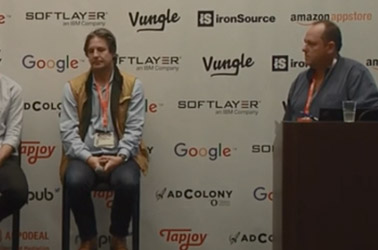
Welcome to the inaugural issue of “IE-nsights.” In conjunction with Gaming Business Review, the team at the Interactive Entertainment Law Group will be giving you our “insights” on a variety of topics pertaining to the games industry. Although many of our articles will have a legal slant to them, many others will simply reflect our impressions and other segments of the industry that the IE Law Group team finds unique and worth sharing. We welcome your feedback on any article as well as future topics.
Our first IE-nsight comes from Colombia. There have been a lot of quality development studios coming from Colombia, most notably Efecto Studios and Brainz.
One of the unique aspects of the Colombian development community is the support that the Colombian government is providing to the studios throughout the country. Although government support at the federal and local levels is not unique in the world, Colombia has a unique approach to working with their local studios.
I had the recent opportunity to sit down with David Luna Sanchez, the Colombian Minister of Information and Communications Technology to discuss the government’s role in promoting the games industry and the local developer community.
Patrick Sweeney: Tell us a bit about how Colombia and MINTIC (Ministerio de Tecnologías de la Información y las Comunicaciones – Ministry of Information and Communications Technology) in particular are supporting the game development community in your country.
Minister Luna: In MINTIC, we support the video game developers’ community by strengthening their technical skills. In order to do so, we have a network composed of 17 labs for the production of digital content in which all people interested in creating video games, animations or applications, may access courses and equipment of the latest technology in different cities throughout the country. In these labs, we have trained more than 19 thousand people through workshops in topics such as programming, usability, video game development, training programs in processes and workflows, among others.
Nowadays, we are inaugurating other 20 digital content laboratories called “Punto Vive Digital Lab”, with the objective to bring this type of opportunities and services to more regions of Colombia, especially to intermediate cities, in order to strengthen the video games community so that they can continue in the road for excellence and growth.
Patrick Sweeney: Traditionally, most governments tend to be a little slow in understanding the game industry and how to support it. As a result, many are often hesitant to take that first step. Can you tell us how MINTIC first approached the concept of working with a new and likely unfamiliar segment of the private sector?
Minister Luna: The Ministry of ICT has been working with the video game industry since 2012. Within the framework of the “Plan Vive Digital para la gente” (Digital Life for People), the Digital Content Initiative was created to strengthen the country’s creative industries, including video games.
I am not going to deny that at the beginning it was difficult to understand the dynamics of this sector, but it has proven to be beneficial that we have always worked closely with video game companies. We also have the support of international experts, which has allowed us to articulate a program that could globalize our industry.
Patrick Sweeney: How did you first learn about the burgeoning development scene in Colombia?
Minister Luna: Being part of the MINTIC team, I was struck by the rapid growth of the creative industries in Colombia and the contribution of these to economic development. Based on this context, we decided to get closer to video game developers and we were able to see the great potential of this industry in Colombia.
In addition to this, another showcase that allowed me to highlight the talent of video game entrepreneurs in Colombia was a program we developed with the Ministry of Culture called “Crea Digital.” This program has awarded dozens of video game developers, and since I saw the prototypes with which they participated, I was convinced of the great talent and quality of the products that are produced in our country.
Patrick Sweeney: Stereotypically, governments do not necessarily understand the nature of the games industry, or software development as a whole. Did you need to do a lot of work in order to understand how the industry works before deciding the best way to support the teams?
Minister Luna: Indeed, one of our main concerns was to understand how the creative industry works. However, due to our possibility to acquire development studios, we could quickly grasp the structure of the industry, its value chain, different monetization models and other features that make it unique. It was through a joint effort with the industry that we modified our services offer to generate greater impact, better support to the sector and optimize our resources.
Patrick Sweeney: Tell us a bit about how you have been supporting game studios throughout the country
Minister Luna: Our services offer has been oriented in three areas. First, the legal one, since in the last tax reform that was carried out in Colombia, we achieved to exclude from sales taxes the main inputs for the development of digital contents (licensing, virtual courses and cloud). In light of this, today it is now cheaper to produce video games.
The second point is promoting the creation of Digital Content, for which each year we put together our program mentioned before “Crea Digital”, which gives monetary resources to video game developers. In this program we have given nearly one million dollars for the development of 31 video games since 2012.
In addition, we have the program for knowledge transfer between video game companies with different degrees of development. Within this pilot, we have invested over US$660 and we have supported 9 Colombian companies from this sector.
Finally, with the help from PROCOLOMBIA, we created a program that aims at promoting access in international markets, for our local companies that develop video games. Since 2012, we have supported thes companies and we have participated in some of the industry’s most important events such as GDC, Gamescom, among others.
Patrick Sweeney: Is there a particular goal or philosophy in mind for your efforts?
Minister Luna: We are implementing recommendations from Colombian industry entrepreneurs. In this sense, we are reorganizing our services offer focusing on the three strategic lines previously depicted. Therefore, we work hard so that our creative industries are recognized worldwide for their quality, creativity and projection and as Ministry of ICT we provide the conditions that are necessary to make this possible. Among this conditions we can find:
- Collaborative work: it is still a very small sector and companies must work together. It is important to understand that in this industry the competitors are not within Colombia, but throughout the world.
- Closing gaps: it is important to close technical, administrative and commercial gaps in companies so that they are competitive on an international level.
- Commercial Management: We want developers to understand this industry as a business.
Patrick Sweeney: I assume that the transfer of knowledge from your more established companies to the newer, more upstart teams is important to foster. Can you talk about ways that you are trying to facilitate that?
Minister Luna: In 2016, we carried out a pilot project called “Conectando a la industria,” (“Connecting the Industry”), in which three consolidated video game companies sponsored two companies with a lower level of development each. From MINTIC, we finance the development of a marketable prototype for each company, its commercial management and the possibility of hiring experts to close technical and commercial gaps.
The results were staggering, the learning curve of smaller companies dropped dramatically. Some companies told us that without the support of the mentors it would have taken two years to reach the level they are today, after only three months of the pilot.
The accompaniment that was carried out impacted several areas of the companies, and best practices were transferred in both the development of video games, plus the administrative and commercial management. This pilot we replicated this year on a smaller scale with a company in Medellin.
Patrick Sweeney: Have you received any feedback or confirmation from the studios about how your efforts are working? Do you work with the teams on a regular basis to address their needs?
Minister Luna: In MINTIC we have a fluid and constant dialogue with video game development studies. We also communicate permanently with the International Game Developers Association (IGDA) in Colombia to review the research needs. This dynamic allowed us to build the pilot I explained above.
In addition to this, development studies have recognized that MINTIC is its most important partner in the Government sector.
Patrick Sweeney: Just as important as what governments SHOULD do is what governments should NOT do. Can you talk about the fine line between supporting and nurturing companies versus stifling them with bureaucracy?
Minister Luna: As part of the Colombian public sector, we have a series of legal restrictions when it comes to supporting different industries. For this reason, we adjust our offer, considering the projects execution times, the facilities in the delivery of resources and the vigilance that involves the use of public money.
Here in MINTIC, we work to achieve balance between what our entrepreneurs need and the restrictions of the execution of public resources.
Our goal is to set the companies off to a good start, making them competitive, but making sure they can survive without our help on the long run.
Patrick Sweeney: Talk a bit about some of the success stories that you’ve seen as a result of MINTIC’s efforts so far.
Minister Luna: There are many success stories that are worth highlighting. For example, Cocodrilo Dog Games, a company specialized in the development of musical games, which developed the video game Moana, one of the most successful films from Disney.
Another example is Brainz which published their latest game, World War Doh, which is one of the most downloaded in both Colombia and Mexico’s Appstores.
BlockWise, a Medellin company that has become a benchmark for developing games for major companies such as Nickelodeon or Cartoon Network. Effect Studios provides services for one of PS: Ark’s best-selling games, and are now developing their new strategy video game called Decoherence, which promises to be a hit.
Finally, Teravision is developing its new video game Neon Fury, making a bet using virtual reality and has received very good critics.
Not to mention the great progress that companies across the country are having, such as Wise in Media (Bogotá), Etheral Games (Armenia), Timba Studios (Medellín), Amazing Souls (Medellín), 12 hit combo (Bogotá), on3d (Bogotá), Below the Game (Bucaramanga), Madbricks (Bogotá), C2 Game (Medellín), just to name a few.
Patrick Sweeney: How does Colombia 4.0 play into your overall strategy? Can you tell me about the event and how it’s helped your efforts in reaching out and working with the local talent throughout your country?
Minister Luna: Colombia 4.0 is our showcase of the creative industry before the world. It is one of the most important Digital Content summits in the country and a reference for Latin America. In the 2016 version, there were about 60,000 attendees between face-to-face and via streaming. In addition, we had 10 tracks, including one of video games and we have 256 speakers from national and international.
In the framework of the summit, we developed a business conference that had expectations for US $ 9 million.
Colombia 4.0 shows that the country is growing in the digital sector and that we have the capacity and the talent to compete with great actors.
Patrick Sweeney: What’s next for MINTIC? How do you expand on your work so far in the coming years?
Minister Luna: We must continue working on giving tools to national talent. That is why we are designing an entrepreneurship program focused on creative digital industries, which we hope to launch this year. In addition, we work to expand the development of video games throughout the country. Taking this into account and thanks to the interest of the Atlantic Governorate (state in Colombia), we will create a Hub of video game companies in this region.
Patrick Sweeney: Where do you see the Colombian game development community in 5 years?
Minister Luna: We want Colombia to be the Latin American benchmark in video game development. We want to be among the 20 countries that export the most creative services. We plan to strengthen the sector following successful cases such as Finland.
Patrick Sweeney: Last question for you…What should the rest of the world know about working with Colombian game studios? What differentiates your studios from others in the world?
Minister Luna: We are very creative, we work hard, we are willing to learn, and we learn fast. In addition, it is important that the world knows that the video game sector has the support of the national government through MINTIC.
Patrick Sweeney: Thank you very much for your time. We look forward to seeing more great games and content coming from Colombia.




0 Comments